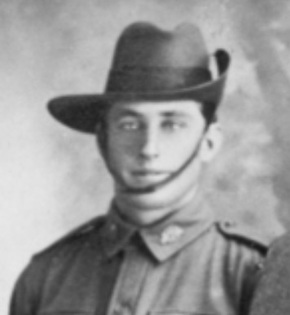
26663
EMERY, Horace Stanley Scott
| Service Number: | 90 |
|---|---|
| Enlisted: | 21 July 1915, Keswick, South Australia |
| Last Rank: | Private |
| Last Unit: | 22nd Infantry Battalion |
| Born: | Magill, South Australia, 8 August 1890 |
| Home Town: | Adelaide, South Australia |
| Schooling: | Not yet discovered |
| Occupation: | Motorman |
| Died: | Springbank, South Australia, 2 October 1950, aged 60 years, cause of death not yet discovered |
| Cemetery: |
West Terrace Cemetery (AIF Section) Section: KO, Road: 6, Site No: 35 |
| Memorials: |
World War 1 Service
| 21 Jul 1915: | Enlisted AIF WW1, Keswick, South Australia | |
|---|---|---|
| 18 Nov 1915: | Involvement AIF WW1, Private, 90, 32nd Infantry Battalion, --- :embarkation_roll: roll_number: '17' embarkation_place: Adelaide embarkation_ship: HMAT Geelong embarkation_ship_number: A2 public_note: '' | |
| 18 Nov 1915: | Embarked AIF WW1, Private, 90, 32nd Infantry Battalion, HMAT Geelong, Adelaide | |
| 11 Nov 1918: | Involvement AIF WW1, Private, 90, 22nd Infantry Battalion |
World War 2 Service
| 27 Sep 1939: | Enlisted Adelaide, SA |
|---|
Help us honour Horace Stanley Scott Emery's service by contributing information, stories, and images so that they can be preserved for future generations.
Add my storyBiography contributed by St Ignatius' College
Emery Horace Stanley Scott was born in South Australia Magill on the 8th of August 1890. His Mother was Mrs W Ternouth.He had a younger brother Edgar Sydney Emery who was born on the 31st of December 1895. Edgar worked as a Gardener whereas Horace worked as Motorman/Mechanic. Emery was 5 foot and 4inches tall and weighed 136 pounds (62kg). He had a fair complexion meaning he had pale skin, along with that he had blue eyes and brown hair. Emery was a methodist which is a branch of Christianity. Emery married to Mrs Dora Emily Susan Emery and their love led to them having a single child.
Emery Horace Stanley Scott and his brother enlisted for war in Keswick south Australia on the 21st of July 1915 when Emery was only 24 and 11 months of age. Emery was given the service number 90 and was put into the 32nd Battalion with his brother. Emery started as a private (the lowest rank) and so did his brother. Emery and his brother trained in Mitcham with the 32nd Battalion and was under the command of Lieutenant Colonel D.M.R Coghill. Emery underwent more training his Battalion was assigned to the 1st reinforcement. Emery and his brother embarked from Adelaide on board the HMAT A2 Geelong, bound for Egypt. (Emery’s brother was promoted to Corporal before the embarked). The 8th Brigade was formed in Egypt in 1916. The 32nd Battalion was assigned to it, as part of the newly raised 5th Australian Division in Egypt. It then proceeded to France, destined for the Western Front, in June 1916.
Emery fought his first major battle with the 32nd Battalion at the Battle of Fromelles. This battle commenced on the 19th of July 1916. But before this battle, there was just bombing, shelling and trench raids causing a few casualties in the 32nd Battalion. 3 days before Fromelles it was known as ‘the nursery’ because of how quiet it was. The area was very flat with high water tables. Trenches were not the only thing used for protection as both Germans and the British force used raised earthworks to protect from artillery and to manage water from flooding below ground defences. It was very hard to attack as the Germans controlled the only high ground.
A major attack was planned where the 32nd Battalion would fix German defenders in position and prevent them from applying reinforcements in the battle of Somme down south. The attack was a mess and killed Emery’s brother along with the other 5000 soldiers,many others were either wounded or captured by German soldiers. Emery was wounded and put into hospital with shell shock on the 20th of July 1916.
In early 1917, the German Army moved back to a defensive line called the Hindenburg Line. This allowed the British forces to push forward, and the 32nd Battalion was part of this advance. However, when there was a big battle to break through the Hindenburg Line during the second battle of Bullecourt, the 32nd Battalion was not directly involved because they were assigned to protect the side. The main battle in 1917 where the 32nd Battalion played a significant role was Polygon Wood. This battle was part of the Third Ypres campaign and took place near a city called Polygon Wood in Belgium on September 26th.
Emery was put in a hospital in France for 2 months until he returned to his Battalion in Staples, France on the 2nd of September 1916. He went back to battle for months until the army granted Emery special leave. Emery went back to battle after his special leave in England, he was in battle for a year until he was granted special leave again on the 7th of February 1918, later returning to his unit in England. He then caught influenza on the 14th of November and was moved to Abbeville France. After 5 days of being sick with influenza he became sick with pneumonia.
Emery arrived back home and went back to his wife at home and continued his normal life and job as a motorman. Emery was awarded 3 medals, The Victory Medal, the Star Medal and the British War medal.
After 20 years, on the 1st of September 1939 World War 2 was declared and once again Emery went to war.
Emery sadly passed at Spring Bank, South Australia on the 2nd of October at the age of 60 due to unknown causes. He was buried at the AIF Cemetery, West Terrace Cemetery, Adelaide, South Australia.












